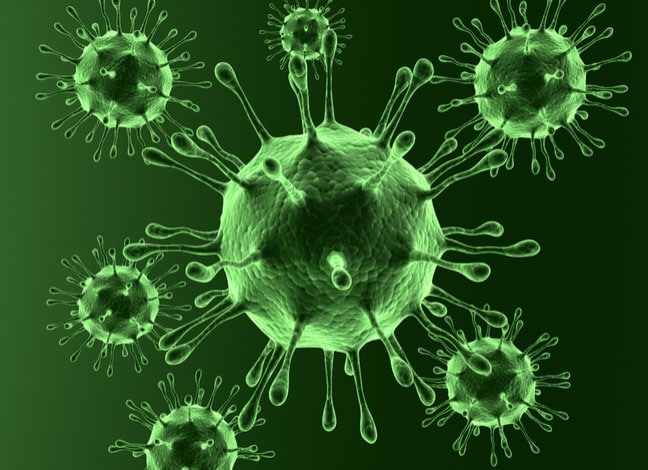There are a variety of reasons why us humans enjoy cannabis, but they typically boil down to one of two things: THC (tetrahydrocannabinol), the psychoactive component, that gets you high as a bird; and CBD (cannabidiol), predominantly sought after for its medicinal effects in treating conditions like epilepsy, and potentially other health benefits. As it turns out, you can thank millions of years ago viruses for gifting cannabis the ability to produce these two chemicals.
In the latest issue of Genome Research, a group of North American scientists have, for the first time ever, published a full map of the cannabis genome. Among the myriad of interesting insights to glean from the chart is the finding that the genes that encode for THC and CBD production evolved thanks to bits of DNA introduced by viruses that infected the plant and successfully colonized its genome millions of years ago.
Other new insights from the map include the discovery of the gene responsible for CBC (cannabichromene—one of the cannabinoids found in marijuana) production, the differentiation of hemp and marijuana (the former produces mainly CBD, while the latter is full of THC), and clues into what might make different cannabis more potent and robust than others.
“One of the problems with breeding in cannabis has been the resources associated with looking at the genome,” says Todd Michael, the Director of Informatics at the J. Craig Venter Institute in La Jolla, California, who was not involved with the study. A lot of the work thus far has sort of involved a trial-and-error process of breeding random strains with one-another, without much knowledge of what particular genetic traits will transfer. “A resource like a genetic map is really like the starting point for high quality breeding, for any plant” says Michael. “All really important crops need these.”
But in the past, obstacles have plagued the development of such a map for cannabis. Legislation has barred researchers from readily studying and experimenting with the plant, even in controlled laboratory settings. On top of that, it’s inherently difficult to map the cannabis genome, thanks to its relatively large size. The larger the genome, the harder it is to categorize, which is why it took so long for scientists to map and make sense of the human genome. The difficulty in sequencing and assembling the cannabis genome was compounded by the viral elements. See, both THC and CBD are made by synthase genes that are found on the same chromosome. But those synthase genes are swarmed by garbled chunks of DNA called retrotransposons, which came from—you guessed it—viruses. Over time, those millions of infectious DNA elements multiplied and spread throughout the genome. The THC and CBD synthase genes are firmly nested in those elements.
It seems the THC and CBD synthase genes came from a single gene, and the viral retrotransposons, as they jumped around and expanded, drove the mutation of the synthase gene sequences in different cannabis strains, spurring the divergence of the gene into THCA (producing THC) in marijuana, and CBDA (producing CBD) in hemp. Michael suggests the transposable elements may have been capable of carrying and moving the synthase gene around itself as they jumped throughout the genome.
The team behind the paper previously published a draft of the genome in 2011, although it was too fragmented to show where specific genes were located on chromosomes. Another genetics firm revealed a cannabis genome map in February, but have not yet published the findings.
According to Michael, having the genome finally fully mapped is going to be “revolutionary” for the cannabis industry. Industry experts will have a much easier time pinpointing what traits to select for in order to yield strains that are easier and faster to grow. But besides turning cannabis into a better growing crop, the genome map should also having significant impacts on fine tuning a strain’s ability to produce THC, CBD, and the hundreds of other cannabinoids specific to cannabis.
“Having a genetic map combined with a high quality genome could possibly enable scientists to target specific pathways, especially for people interested in the psychoactive components of cannabis,” says Michael. For example, you could modify the terpene profile in cannabis to modulate the high you get from the plant. You could also change what sort of smells the plant produces. Armed with the map of the genome, researchers could even use a tool like CRISPR to directly edit those features at the genetic level.
While the role of ancient viral elements in the evolutionary history of THC and CBD production is a neat insight, to most scientists, it’s not all that surprising. “In general, this is basically how plants evolve,” says Michael. “I’m not really sure why the media has picked up on this so aggressively.” Researchers have long known that retrotransposons have viral origins. “We know that genome size in plants is almost 100 percent due to the expansion of retrotransposons. This isn’t anything new. And we know they play a large role in the evolution of plants.”
Instead, Michael argues the more critical insights from the paper have to do with illustrating what genes may or may not be active, since that will give researchers a better understanding of what points are worth tinkering around with and what areas ought to be avoided.
Michael is particularly excited about the future of high-CBD products as a substitute for opioids. “We’ve got a huge opioid epidemic,” he says, “and it’s been shown that CBD, and THC, can play a role in managing pain.”
Ultimately, the new genome map is sure to spur a host of new work in recreational and medicinal cannabis applications. “There is a lot of great work that’s coming out,” says Michael. “In the next year we’re going to see a lot of really fantastic things in cannabis genomics.”














